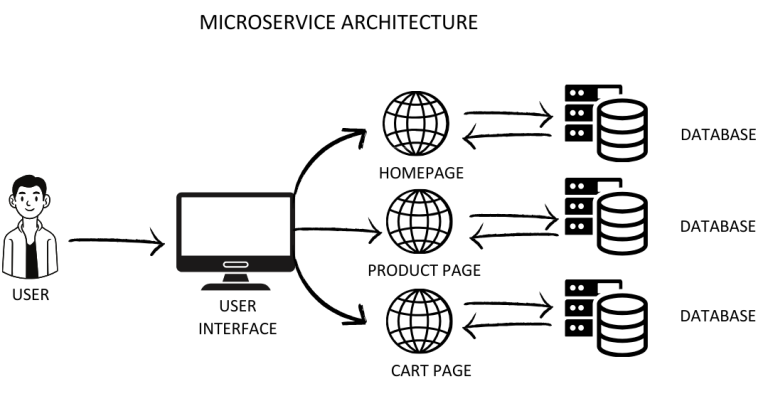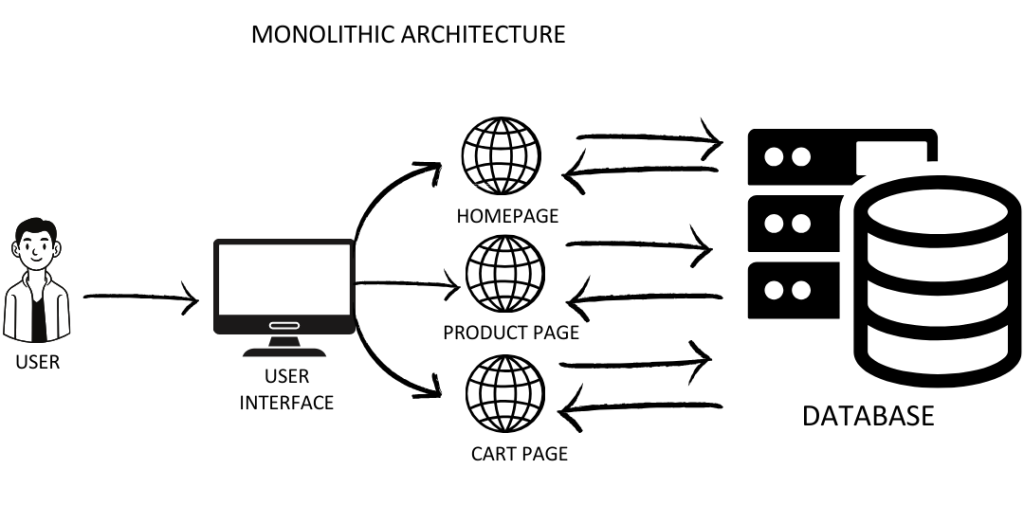Mastering Microservices: Revolutionizing Software Development for Modern Applications
- May 10, 2024
- nschool
- 0

Introduction
Microservices are a modern approach to building software applications where the application is composed of small, independent services that each perform a specific function. These services communicate with each other through APIs, enabling them to work together seamlessly. microservices allow for greater flexibility, scalability, and resilience. Each microservice can be developed, deployed, and scaled independently, making it easier to maintain and update the application over time. This modular approach to software development promotes agility and accelerates the delivery of new features and updates.
How Microservice Architecture Works?
Microservice architecture works by breaking down a complex application into smaller, independent services, each responsible for a specific task or function. These services interact with one another via APIs (Application Programming Interfaces), commonly employing lightweight protocols such as HTTP or messaging queues.
In practice, this allows development teams to work on different services simultaneously, using different programming languages, frameworks, or databases best suited for their tasks. It also enables faster deployment of updates or new features, as changes to one service don’t require modifying the entire application.
Microservices promote fault isolation. If one service fails, it doesn’t bring down the entire system, as other services can continue to operate independently. This enhances the system’s resilience and availability.

Advantages of Microservice Architecture
Microservices offer several distinct advantages that make them more special compared to other alternatives:
1. Scalability: Microservice architecture allows for horizontal scaling, enabling each service to scale independently according to demand. This fine-grained scalability ensures optimal resource utilization and enables applications to handle varying workloads more efficiently compared to other architectures.
2. Flexibility: Microservices provide flexibility in technology choice, allowing developers to use different programming languages, frameworks, and tools for each service. This flexibility promotes innovation and enables teams to adopt the best technologies for specific tasks, which may not be possible with other architectures that have stricter technology constraints.
3. Resilience: In a microservices architecture, failures are isolated to the affected service, minimizing the impact on the overall system. This fault isolation enhances system resilience and ensures uninterrupted service delivery, a feature that is crucial for maintaining high availability in modern applications.
4. Modularity: Microservices promote a modular approach to development, where each service focuses on a specific task or functionality. This modularity makes it easier to understand, develop, test, deploy, and maintain individual components of the application, compared to monolithic architectures where all components are tightly coupled.
5. Continuous Delivery: Microservices architecture facilitates continuous integration and delivery (CI/CD) practices, enabling developers to deploy changes to individual services quickly and frequently. This allows organizations to iterate rapidly, respond to customer feedback, and deliver new features to market faster compared to architectures that have longer deployment cycles.
Real Time Microservice Using Platforms
Microservices are widely used in various industries and applications, offering real-time solutions to address specific challenges and requirements. Here are some examples of real-time microservice usage:
1.E-commerce Platforms: E-commerce platforms utilize microservices to handle various functionalities such as user authentication, product catalog management, order processing, and payment processing. Each of these functionalities can be implemented as independent microservices, allowing for scalability and resilience to handle high traffic volumes, especially during peak shopping seasons or promotional events.
2.Financial Services: Financial services companies leverage microservices to build scalable and resilient applications for banking, payment processing, trading platforms, and risk management systems. Microservices enable these companies to handle large transaction volumes in real-time while ensuring security, compliance, and fault tolerance.
3.Streaming Platforms: Streaming platforms like Netflix, Spotify, and Twitch rely on microservices to deliver real-time content to millions of users worldwide. Microservices architecture allows these platforms to scale dynamically based on user demand, deliver personalized recommendations, and ensure high availability and low latency for streaming media content.
4.Travel and Hospitality: Travel and hospitality companies use microservices to power their booking systems, reservation management, customer service platforms, and loyalty programs. Microservices enable these companies to handle fluctuating demand, integrate with third-party services and APIs, and provide personalized experiences for travelers in real-time.
5.IoT (Internet of Things): IoT applications leverage microservices to manage device communication, data processing, analytics, and control systems. Microservices architecture enables IoT platforms to handle massive amounts of data generated by connected devices, respond to events in real-time, and support complex workflows for home automation, smart cities, industrial automation, and healthcare monitoring systems.
6. Gaming Industry: Online gaming platforms utilize microservices to handle player authentication, matchmaking, game sessions, leaderboards, and in-game purchases. Microservices enable gaming companies to scale their infrastructure dynamically, deliver seamless multiplayer experiences, and introduce new game features and updates in real-time.
Alternative to Microservice Architecture
An alternative to microservices architecture is monolithic architecture. In a monolithic architecture, the entire application is built as a single, cohesive unit, with all components tightly integrated into a single codebase. Unlike microservices, which consist of independent services communicating with each other, monolithic applications have all functionalities contained within one large application.
While microservices offer benefits such as scalability, flexibility, and resilience, monolithic architecture has its advantages as well, including simplicity, ease of development, and deployment. However, monolithic architectures may face challenges with scalability, maintainability, and resilience as applications grow larger and more complex.
Other alternatives to microservices architecture include service-oriented architecture (SOA), where services are larger and more coarse-grained compared to microservices, and serverless architecture, where applications are built using serverless computing platforms that handle infrastructure management and scaling automatically. Each architectural approach has its own set of strengths and weaknesses, and organizations should choose the one that best fits their specific requirements and constraints.

Difference between Microservice and Monolithic Architecture
| Aspect | Microservice Architecture | Monolithic Architecture |
| Structure | Application is divided into small, independent services | Entire application is built as a single, cohesive unit |
| Commu nication | Services communicate with each other using lightweight protocols. | Components communicate directly within the same process |
| Scalability | Horizontal scaling of individual services is possible | Scaling involves scaling the entire application |
| Flexibility | Offers flexibility in technology choice for each service | Technology choices are uniform across the application |
| Fault Isolation | Failures are isolated to individual services | Failures may impact the entire application |
| Development | Supports independent development, deployment, and scaling of services | Development, deployment, and scaling are centralized |
| Maintenance | Easier to maintain and update individual services | Updating the entire application may be complex |
| Dependency Management | Low coupling between services, reducing dependencies | Tight coupling between components may lead to dependencies |
| Deployment | Each service can be deployed independently | Deployment involves deploying the entire application |
| Testing | Easier to test individual services | End-to-end testing may be more complex |
| Complexity | Complexity is distributed among services | Complexity is concentrated within the monolith |
| Resource Utilization | Optimal resource utilization due to independent scaling | Resource utilization may not be as optimal due to scaling |
Alternative to Microservice Architecture
While microservices offer numerous benefits, they also come with several challenges that organizations may encounter during implementation. Some of the key challenges in microservices architecture include:
1.Complexity: Handling numerous microservices may lead to challenges in tasks like service discovery, communication, configuration, and orchestration.Coordinating interactions between services and ensuring consistency across the system can become challenging as the application grows.
2.Distributed Systems: Microservices architecture involves distributed systems where services communicate over a network. This introduces challenges related to network latency, reliability, and security. Managing communication between distributed services and handling failures gracefully require careful planning and implementation.
3.Data Management: Microservices architecture often leads to data fragmentation, where each service has its own database or data store. Ensuring data consistency, integrity, and synchronization across multiple databases can be complex and may require implementing distributed transactions or eventual consistency patterns.
4.Deployment and Monitoring: Deploying and monitoring microservices at scale can be challenging. Managing deployments, versioning, and rollbacks across numerous services requires robust deployment pipelines and monitoring solutions. Monitoring the health, performance, and availability of distributed services also becomes critical for maintaining system reliability.
5.Dependency Management: Microservices architecture relies on service composition, where services depend on each other to fulfill business requirements. Managing dependencies between services and ensuring backward compatibility when making changes or updates can be challenging and requires careful coordination between development teams.
6.Testing: Testing microservices presents unique challenges, as each service needs to be tested in isolation as well as in combination with other services. Implementing comprehensive testing strategies, including unit tests, integration tests, and end-to-end tests, becomes essential to ensure the overall system behaves as expected.
7.Operational Overhead: Operating and maintaining a microservices-based system can introduce additional operational overhead compared to monolithic architectures. Managing infrastructure, monitoring, logging, security, and compliance across multiple services requires dedicated resources and expertise.
8.Cultural Shift: Adopting microservices architecture often requires a cultural shift within organizations. Teams need to embrace principles such as decentralization, autonomy, and continuous improvement. This may require changes to existing processes, organizational structures, and communication patterns.
Conclusion
Microservice architecture revolutionizes software development by breaking down applications into smaller, independent services that communicate through APIs. This modular approach offers flexibility, scalability, and resilience, allowing services to be developed, deployed, and scaled independently. Microservices excel in real-time scenarios, such as e-commerce platforms or streaming services, where responsiveness and scalability are crucial. However, implementing microservices comes with challenges like complexity, managing distributed systems, and handling data fragmentation. Despite these challenges, the benefits of microservice architecture, including agility, scalability, and fault isolation, make it a preferred choice for building complex, distributed applications in today’s dynamic environments.

